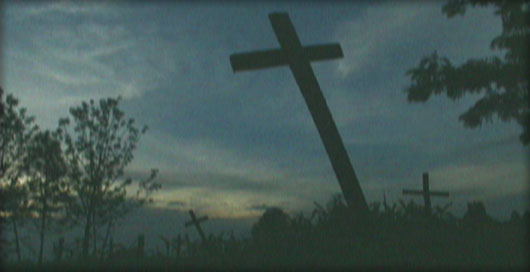
Home | |||
Pre-Viewing Lesson Plan | |||
Viewing Lesson Plan | |||
Post-Viewing Lesson Plan | |||
Further Resources | |||
Printable .pdf of Entire Guide (Adobe Acrobat required) | |||
» About the film:
FRONTLINE marks the 10th anniversary of the Rwandan genocide with a documentary chronicling one of the worst atrocities of the 20th century. In addition to interviews with key government officials and diplomats, the two-hour documentary offers groundbreaking, eyewitness accounts of the genocide from those who experienced it firsthand: from Tutsi survivors who recount the horror of seeing their friends and family members slaughtered by neighbors and coworkers; to the UN peacekeepers stationed amid the carnage who were ordered not to intervene; to those holding positions of power at the White House. Through these accounts, FRONTLINE illustrates the social, political, and diplomatic failures that enabled the slaughter of 800,000 people to occur unabated and unchallenged by the global community.
» A Note to Teachers
For classes in Social Studies, Journalism, Language Arts and Current Events; Grade level 9th-12th
Asking students to grapple with an issue as horrible as genocide, termed "the crime without a name" by British Prime Minister Winston Churchill, is a daunting, wrenching, and, above all, sad challenge. Yet, as the film "Ghosts of Rwanda" shows, while people and governments turned their backs on what was happening in Rwanda in the spring of 1994, some individuals stood up to the horror and acted effectively, often with breathtaking heroism. Students can witness both the depths to which humans can sink and the heights to which they can soar. This guide offers classroom teachers an array of opportunities to teach history and to explore the notion of individual and collective responsibility.
» Brief Overview of Genocide
(Note: The following is excerpted from The Genocide Convention at Fifty by William Schabas of the U.S. Institute of Peace. Teachers should distribute this excerpt to all students.)
The destruction of ethnic groups has marred the progress of human history almost from its beginnings. There are reports of genocide-like massacres in the writings of the ancient Greeks and in the history of the Middle Ages. Indigenous populations in the Western Hemisphere, Africa, and elsewhere were sometimes slated for elimination by their "discoverers" or their colonizers. But ethnic massacre truly seems to have flourished in the twentieth century. The first great genocide of the era dates to the First World War when hundreds of thousands of Armenians were destroyed despite the protests of Western diplomats who, possibly for the first time, called such killings a "crime against humanity." In the Second World War, after nearly a decade of mounting anti-Semitism, Hitler undertook what he called the "final solution," reminding his generals that "nobody remembers the Armenians."
Churchill called it "the crime without a name," and it was only in 1944 that a Jewish refugee from Poland teaching in the United States, Raphael Lemkin, coined the term genocide in his book Axis Rule in Occupied Europe. Lemkin's neologism was rapidly accepted. In 1945, the Nuremberg prosecutors charged genocide in the indictment of Goering, Hess and the others, although the judges of the International Military Tribunal kept with the official terminology used in their statute and described the Nazi atrocities as "crimes against humanity." After the Nuremberg judgment, the UN General Assembly declared genocide an international crime and directed that a treaty aimed at its prevention and punishment be drafted.
» Lesson Plans:
Pre-Viewing Lesson Plan:
Learning about Rwanda
Students will learn about key events in Rwandan history, terms used in the film, and the basic principles of the United Nations. They will discuss the meaning of genocide and explore different points of view in reporting an historical event.
Lesson Extension:
Genocide in World War II and its Aftermath
Students will trace the progress of the 1935 Nuremberg Laws to the Wannsee Conference plans for the "Final Solution," to the International Military Tribunal trials of Nazi war criminals at Nuremberg after World War II.
Viewing Lesson Plan:
Student Viewing Guide
Students will be assigned to take notes from a particular perspective while viewing the film. As a large group, the class will discuss the impact of the film.
Post-Viewing Lesson Plan:
The Big Picture
Students will explore the different actions and reactions of people and groups who were involved in Rwanda.
Lesson Extension:
The Aftermath of Genocide
Students will read articles and consider what happens after genocide.Reconciliation and Reparations in Rwanda
Students will have the opportunity to learn about both the International Military Court of Justice and the gacaca, the grass-roots level courts for those who participated in the genocide but were not leaders.
» Purchasing the Video
"Ghosts of Rwanda" can be purchased from ShopPBS for Teachers.
» Credits
This teacher guide was developed by Simone Bloom Nathan of Media Education Consultants. It was written by Ellen Greenblatt of University High School, San Francisco. Pat Grimmer, chair of the Social Studies Department at Carbondale Community High School in Carbondale, Ill. was an adviser.
home » previous reports » watch online » about us » teacher center » newsletter » email FRONTLINE
privacy policy » wgbh » pbsi
web site copyright WGBH educational foundation